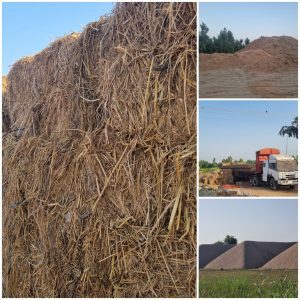Introduction
In today’s world, demand for affordable and sustainable energy solutions is growing rapidly. Pakistan’s energy landscape is evolving, with a mix of fossil fuels, nuclear, solar, wind, hydro, geothermal, and biomass-based options. Understanding each method helps businesses, policymakers, and industries make informed decisions. As a leading biomass supplier in Pakistan, Babar Aziz Balers (babalers.com) aims to explain how different energy generation methods work and highlight why biomass energy is an essential part of our energy mix.
1. Fossil Fuel–Based Energy Generation
1.1 Coal
Coal-fired power plants remain a major source of electricity around the world. In these plants, coal is burned to produce steam, which drives turbines connected to generators. Although coal is relatively inexpensive and abundant, it releases significant greenhouse gases (CO₂) and pollutants (SO₂, NOₓ, particulate matter), making it a less environmentally friendly option.
1.2 Oil
Oil-fired power plants burn petroleum products to produce steam or operate combustion engines that generate electricity. While oil is more commonly used in transportation and industrial processes, some utilities still rely on it for electricity. Like coal, oil combustion emits considerable CO₂ and other pollutants.
1.3 Natural Gas
Natural gas plants burn methane-rich gas in gas turbines or combined-cycle systems. Combined-cycle gas turbines (CCGT) achieve high thermal efficiency (often over 60%). Natural gas emits less CO₂ per kWh than coal or oil and produces lower levels of NOₓ and SOₓ, positioning it as a preferred “bridge fuel” during the transition toward renewables.
2. Nuclear Energy
Nuclear power plants use uranium or plutonium to generate heat through nuclear fission. This heat produces steam that spins turbines to generate electricity. Nuclear energy provides large amounts of baseload (continuous) power with almost zero direct CO₂ emissions. Concerns include high capital costs, long construction times, radioactive waste management, and potential safety risks.
3. Renewable Energy Sources
Renewable sources harness naturally replenishing resources and have lower environmental impacts. Major renewable methods include:
3.1 Solar Energy
- Solar Photovoltaic (PV): PV panels convert sunlight directly into electricity.
- Solar Thermal: Concentrating mirrors focus sunlight to heat fluids and produce steam for turbines.
Pakistan has abundant solar potential, especially in provinces like Balochistan and Sindh. Solar output can be intermittent due to day/night cycles and weather, so storage or backup systems are often required.
3.2 Wind Energy
Wind turbines convert the kinetic energy of wind into mechanical energy and then into electricity. Pakistan’s Gharo-Keti Bandar wind corridor offers high wind potential. Wind energy is variable, depending on wind speed, so grid integration and storage solutions are important for maintaining stability.
3.3 Hydropower
Hydropower plants use flowing water to turn turbines and generate electricity. Large dams (e.g., Tarbela, Mangla) and smaller run-of-river projects supply reliable, dispatchable power in Pakistan. Environmental impacts such as resettlement and ecosystem disruption are concerns, but small and micro-hydro projects have become popular for off-grid and rural electrification.
3.4 Geothermal Energy
Geothermal plants tap into Earth’s natural heat—usually from underground hot water or steam reservoirs—to drive turbines. Geothermal energy offers consistent baseload power with minimal emissions. Pakistan’s Chagai Hills region shows geothermal potential, though exploration and development costs are currently high.
4. Biomass Energy: An Overview
Biomass energy uses organic materials—agricultural residues, forestry byproducts, and animal waste—to produce heat, electricity, or biofuels. When managed sustainably, biomass is considered carbon-neutral because the CO₂ emitted during combustion roughly equals the CO₂ absorbed during feedstock growth.
4.1 What Is Biomass?
Biomass refers to any biological material derived from plants or animals, such as:
- Wheat straw, rice husk, and corn stalks
- Sugarcane bagasse and cotton stalks
- Forestry residues like wood chips and sawdust
- Animal manure and poultry litter
- Energy crops (e.g., jatropha, switchgrass)
4.2 How Biomass Energy Works
There are three main pathways to convert biomass into usable energy:
- Direct Combustion: Burning biomass in boilers or furnaces to produce steam for turbines or industrial processes (e.g., rice husk–fired boilers in brick kilns).
- Thermochemical Conversion: Gasification and pyrolysis break down biomass into syngas (CO + H₂) or bio-oil, which can generate electricity or produce biofuels (e.g., gasifier-based power plants using sawdust).
- Biochemical Conversion: Fermentation processes use microorganisms to produce bioethanol or anaerobic digestion to produce biogas (methane) from manure (e.g., biogas digesters converting animal manure into cooking gas or small-scale power).
4.3 Advantages of Biomass Energy
- Carbon Neutrality: Sustainable biomass feedstocks reduce net CO₂ emissions.
- Local Economic Benefits: Creates rural jobs in farming, collection, processing, and transport.
- Baseload Capability: Unlike solar and wind, biomass can produce continuous power 24/7.
- Waste Management: Utilizes agricultural and animal waste that might otherwise pose disposal problems.
5. Biomass Energy in Pakistan
Pakistan’s agriculture sector generates millions of tons of crop residues annually—straw, husk, bagasse, and stalks—that can be converted into biomass energy. Key points include:
- Abundant Feedstock: Punjab and Sindh provinces produce large volumes of rice husk, wheat straw, and sugarcane bagasse.
- Rural Electrification: Small-scale biomass gasifiers and biogas plants offer off-grid power solutions in remote villages.
- Industrial Use: Many brick kilns and cement factories are transitioning to biomass to lower fuel costs and reduce emissions.
- Government Incentives: Initiatives promote renewable energy, including tax breaks and subsidies for biomass-based projects.
5.1 Role of Babar Aziz Balers
At Babar Aziz Balers (babalers.com), we have been a leading biomass supplier in Pakistan since 1988. Our specialties include:
- Collecting and baling agricultural residues (rice husk, wheat straw, cotton stalks, sugarcane bagasse)
- Ensuring moisture content below 12% through rigorous quality checks
- Delivering high-density bales ready for industrial boilers and power plants
- Offering logistics, climate-controlled storage, and export assistance
By partnering with industries and power producers, we help reduce reliance on fossil fuels and support Pakistan’s transition to cleaner energy.
6. Conclusion
Pakistan’s future energy security depends on diversifying beyond traditional fossil fuels. While solar, wind, and hydropower projects are gaining momentum, biomass energy remains a reliable, carbon-neutral option—especially for rural areas and industries. As a dedicated biomass supplier in Pakistan, Babar Aziz Balers is committed to delivering quality biomass feedstock, enabling businesses to adopt cost-effective and eco-friendly energy solutions. Contact us today to learn how our bales of straw, husk, or bagasse can power your operations and reduce your carbon footprint.
7. Frequently Asked Questions (FAQs)
- What is the most cost-effective biomass feedstock in Pakistan?
Rice husk and wheat straw are generally the most abundant and affordable. Babar Aziz Balers offers moisture-controlled, high-density bales at competitive prices. - Can biomass fully replace natural gas in power plants?
In many cases, biomass can co-fire with natural gas or coal—reducing emissions and fuel costs. Fully converting requires boiler modifications which has succesfully been done by many factories throughout Pakistan, which Babar Aziz Balers can advise on. - How do I ensure consistent biomass quality?
At Babar Aziz Balers, we conduct moisture tests, ash-content analysis, and purity checks before baling. - How can I contact Babar Aziz Balers?
Visit our website at www.babalers.com, email us at info@babalers.com or call
0313-2222527 to request a quote or discuss your biomass requirements.



